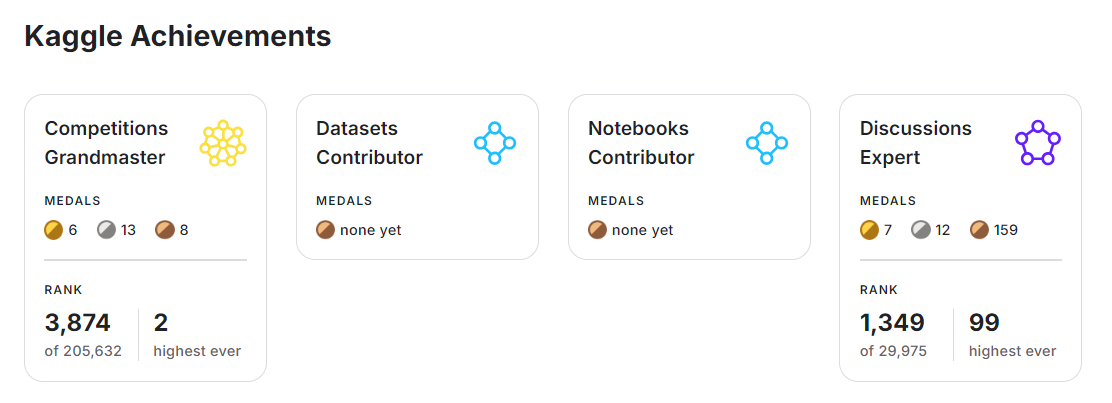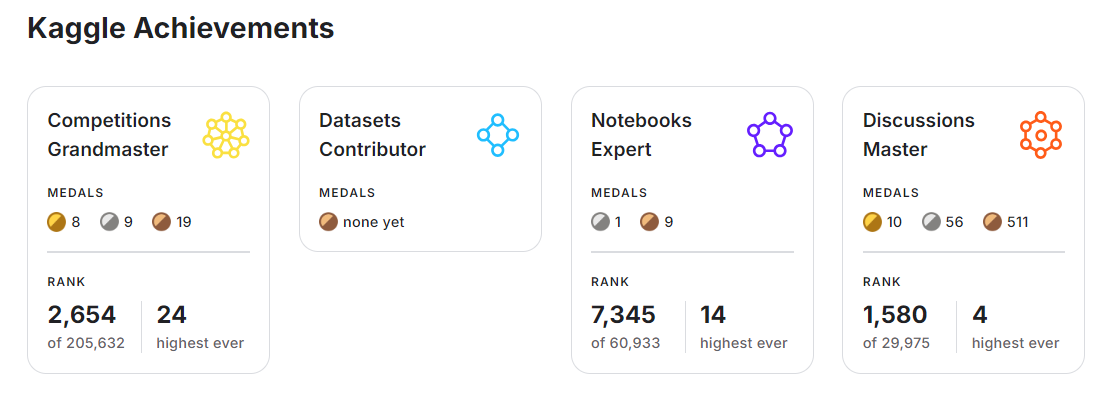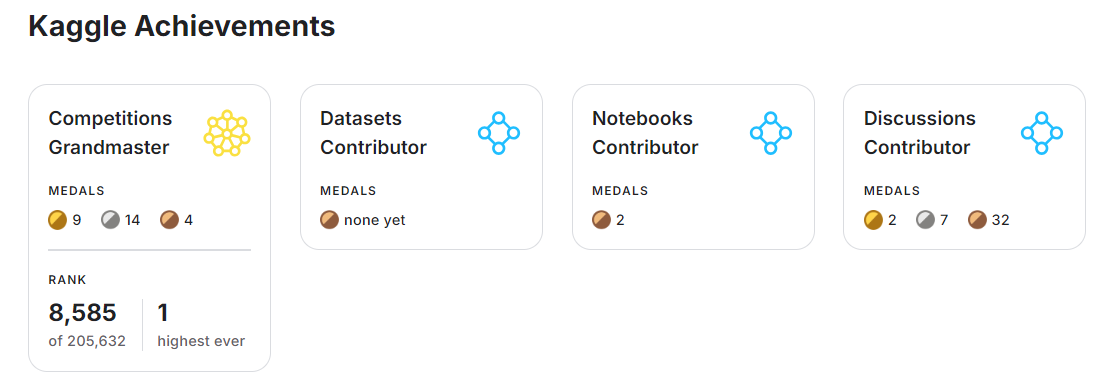Introduction
Kaggle, the home of data science competitions, has identified all these top performers for continuously producing quality creative solutions to otherwise tough problems. The Kaggle Grandmaster is proficient in analyzing data, engineering features, and building various models, and the participant also shares his/her knowledge with the community. Dedication to getting to the top of Kaggle entails understanding the basics of machine learning, critical thinking, and the best and most efficient utilization of Python libraries. This article will examine the top Python libraries utilized by Kaggle Grandmasters.
Who is a Kaggle Grandmaster?
Kaggle Grandmaster is a title given to users who rank the highest in the Kaggle, a top website for data science and machine learning competition. The Kaggle Grandmasters have shown their prowess in data analysis, feature engineering, and aspects of model building by performing perfectly in various competitions. The concept of attaining the level of the Grandmaster itself involves technical skills, skillfulness, and concerns in machine learning and statistical competence.
How to Kaggle Grandmasters Utilize Python Libraries?
Kaggle Grandmasters rely heavily on a suite of Python libraries to perform data manipulation, numerical computations, model building, and visualization. Here is how they utilize some of the top Python libraries:
- Pandas: Cleaning, merging, and transforming datasets to prepare them for analysis and modeling. For instance, Grandmasters use Pandas to handle missing values, create new features, and filter data.
- NumPy: NumPy efficiently performs array operations and mathematical computations. It performs matrix operations and statistical calculations and integrates with other libraries like Pandas and Scikit-learn.
- Scikit-learn: Building and evaluating machine learning models. Grandmasters use Scikit-learn for its wide range of algorithms, including classification, regression, clustering, and preprocessing tools like scaling and encoding.
- Matplotlib: Creating plots and charts to visualize data distributions, trends, and model performance. This helps in exploratory data analysis and in effectively presenting results.
- Seaborn: Creates attractive and informative statistical graphics. It is used with Matplotlib to enhance visualizations with additional features like heatmaps and pair plots.
- XGBoost: Implementing gradient boosting algorithms to improve model accuracy and performance. XGBoost is favored for its speed and efficiency, making it a go-to choice for competitions.
- LightGBM: Handling large datasets efficiently and training models quickly. LightGBM has fast training times and low memory usage, which are crucial in competitive environments.
Top Python Libraries by Kaggle Grandmasters
Let us now look at the top Python Libraries used by Kaggle Grandmasters.
Alexander Larko (alexxanderlarko)
Alexander Larko efficiently manipulates and cleans data, crucial in high-stakes competitions where data quality can significantly impact model performance.

Python Libraries Utilized by Kaggle Grandmaster:
- Pandas is used extensively for data manipulation and cleaning. Larko employs Pandas to handle dataframes and perform operations like merging, filtering, and aggregating data, forming his preprocessing pipeline.
- NumPy is essential for numerical operations, especially with arrays and matrices.
- Scikit-learn is a go-to library for machine learning models and preprocessing tasks. Larko leverages its various algorithms and utilities for feature selection, scaling, and model evaluation.
- XGBoost is a staple in Larko’s Clarkson toolkit. Its ability to handle large datasets efficiently and provide accurate results makes it a preferred choice.
- LightGBM is valued for its speed and efficiency, particularly with large datasets. Kaggle Grandmaster uses this Python library for its quick training times and ability to handle high-dimensional data.
Check out Alexander Larko’s Kaggle Profile Here
Sali Mali (salimali)
Sali Mali stands out for his data visualization and model evaluation expertise, which helps him extract meaningful insights and refine models effectively.

Python Libraries Utilized by Kaggle Grandmaster:
- Pandas is integral for handling and analyzing data, enabling Mali to perform data-wrangling tasks effortlessly.
- Matplotlib is essential for creating visualizations. It allows Mali to plot data trends, distributions, and other critical insights that guide the modeling process.
- Seaborn is used for statistical data visualization, enhancing the readability and aesthetics of plots from data analyses.
- Scikit-learn is a crucial library for building and evaluating machine learning models. Mali relies on its comprehensive suite of algorithms and metrics to fine-tune models.
- Keras is a Python library that is used to develop deep-learning models due to its simplicity and flexibility. Kaggle Grandmaster uses it to build, train, and evaluate neural networks efficiently.
Check out Sali Mali’s Kaggle Profile
Michael Jahrer (mjahrer)
Michael Jahrer’s prowess in building and evaluating models, particularly with tabular data. He frequently appears in Kaggle competitions.

Python Libraries Utilized by Kaggle Grandmaster:
- Pandas is fundamental for data manipulation, allowing Jahrer to preprocess and transform data effectively.
- NumPy is used for array operations and mathematical computations, providing the computational backbone for many algorithms.
- Scikit-learn is extensively used for model building and evaluation. Jahrer utilizes its diverse tools for preprocessing, model selection, and validation.
- LightGBM is preferred for its performance with tabular data, which provides quick training and high accuracy. Jahrer often uses it in ensemble methods to boost overall performance.
- XGBoost is known for its accuracy and speed, it is a staple in Jahrer’s arsenal, especially for its gradient-boosting framework that enhances prediction accuracy.
Check out Michael Jahrer’s Kaggle Profile Here
Yasser Tabandeh (yassertabandeh)
Yasser Tabandeh demonstrates exceptional skills in traditional machine learning and deep learning, making him a versatile competitor in various Kaggle challenges.

Python Libraries Utilized by Kaggle Grandmaster:
- Pandas is extensively used for data manipulation. Kaggle Grandmaster leverages Pandas to clean, merge, and transform datasets, preparing them for further analysis.
- NumPy is essential for numerical operations, mainly when dealing with large arrays and performing mathematical computations. It complements Pandas in data preprocessing tasks.
- Matplotlib is utilized to create plots and charts, helping Tabandeh visualize data distributions, trends, and the results of model evaluations.
- Scikit-learn is a crucial library for machine learning tasks, including model building, evaluation, and preprocessing. Tabandeh uses Scikit-learn for its comprehensive suite of algorithms and utilities.
- TensorFlow is preferred for deep learning applications. Tabandeh employs TensorFlow to build, train, and optimize neural networks for complex prediction tasks.
Check out Yasser Tabandeh’s Kaggle Profile Here
Christopher Hefele (chefele)
Christopher Hefele stands out for his expertise in data handling and implementing advanced machine learning models, contributing to his high rankings in numerous Kaggle competitions.

Python Libraries Utilized by Kaggle Grandmaster:
- Pandas is used for efficient data handling, allowing the manipulation of dataframes, cleaning data, and preparing datasets for modeling.
- NumPy is critical for performing mathematical operations on arrays, providing the computational power needed for efficient data processing.
- Scikit-learn is a go-to library for implementing machine learning algorithms. Hefele uses it for building, training, and evaluating various models, from basic classifiers to complex ensembles.
- Matplotlib is employed to create visualizations that help interpret data insights and model performance metrics.
- Keras developers prefer it for building neural network models because its user-friendly interface and integration with TensorFlow enable Hefele to experiment with deep learning architectures easily.
Check out Christopher Hefele’s Kaggle Profile Here
José H. Solórzano (solorzano)
José H. Solórzano demonstrates proficiency in model-boosting techniques and efficient data manipulation, which leads to high-performing models in Kaggle competitions.

Python Libraries Utilized by Kaggle Grandmaster:
- Pandas is fundamental for data manipulation and analysis. Solórzano uses Pandas to handle large datasets, perform data cleaning, and create new features.
- NumPy is important for numerical computations, especially when dealing with matrix operations and performing statistical analyses.
- Scikit-learn builds machine learning models and preprocesses tasks such as scaling and encoding features.
- XGBoost boosts models and improves prediction accuracy through gradient-boosting algorithms. Solórzano leverages XGBoost for its robust performance in structured data.
- LightGBM is efficient and fast, particularly when handling large datasets. Solórzano uses LightGBM to train models quickly and achieve high accuracy with less computational cost.
Check out José H. Solórzano’s Kaggle Profile Here
Konrad Banachewicz (konradb)
Konrad Banachewicz and his robust data manipulation and model-building skills have earned him top spots in numerous Kaggle competitions.

Python Libraries Utilized by Kaggle Grandmaster:
- Pandas is essential for data manipulation. Banachewicz uses Pandas to clean, merge, and transform dataframes, ensuring data is in the optimal format for analysis and modeling.
- NumPy is critical for array and numerical operations. He employs NumPy for its efficient handling of large datasets and array manipulation capabilities, which are foundational for many machine learning algorithms.
- Scikit-learn is a vital tool for machine learning and preprocessing. Banachewicz leverages Scikit-learn’s suite of algorithms and preprocessing tools to build, train, and evaluate models.
- Matplotlib is utilized for data visualization. He creates plots and charts with Matplotlib to explore data distributions, understand relationships, and present model results.
- Keras is the preferred platform for deep learning tasks. Banachewicz uses Keras to develop, train, and fine-tune neural network models, benefiting from its user-friendly API and integration with TensorFlow.
Check out Konrad Banachewicz’s Kaggle Profile Here
David J. Slate (dslate)
David J. Slate is known for his analytical prowess and expertise in boosting algorithms. This Kaggle Grandmaster has had significant success in various Kaggle challenges.

Python Libraries Utilized by Kaggle Grandmaster:
- Pandas is used for data analysis. To derive meaningful insights, slate relies on Pandas to perform data-wrangling tasks, such as filtering, grouping, and aggregating data.
- NumPy is important for numerical operations. He uses NumPy for its efficient numerical computation capabilities, essential for handling large-scale data and complex mathematical operations.
- Scikit-learn is employed for machine learning models. Slate utilizes Scikit-learn’s algorithms and tools for preprocessing, model training, and evaluation.
- Matplotlib creates visualizations. He employs Matplotlib to generate various plots and graphs that help visualize data trends, distributions, and model performance.
- XGBoost is preferred for boosting algorithms. Slate leverages XGBoost for its robust gradient boosting framework, which enhances model accuracy and performance, especially with structured data.
Check out David J. Slate’s Kaggle Profile Here
Bluefool (domcastro)
Bluefool has high performance in Kaggle competitions. He has consistently delivered top-tier solutions using advanced machine-learning techniques.

Python Libraries Utilized by Kaggle Grandmaster:
- Pandas are extensively used for data manipulation. Castro employs Pandas to clean, merge, and transform datasets, which is crucial for preparing data for analysis and modeling.
- NumPy is essential for numerical computations. He uses NumPy for its fast array operations and mathematical functions, which underpin many preprocessing and modeling steps.
- Scikit-learn is a primary tool for building and evaluating models. Castro leverages Scikit-learn’s diverse algorithms and preprocessing tools to develop robust machine-learning pipelines.
- XGBoost is commonly used for its performance in competitions. Castro uses XGBoost for its powerful gradient-boosting algorithms, which deliver high accuracy and efficiency.
- LightGBM is fast and can efficiently handle large-scale data, making it ideal for competition settings where performance is critical.
Check out Bluefool’s Kaggle Profile Here
Alexander D’yakonov (dyakonov)
Alexander D’yakonov, a distinguished Kaggle Grandmaster, demonstrates exceptional analytical skills and innovative solutions in data science competitions. His expertise spans a wide range of machine-learning techniques.

Python Libraries Utilized by Kaggle Grandmaster:
- Pandas are essential for data handling and analysis. D’yakonov uses Pandas to perform complex data manipulations and exploratory data analysis.
- NumPy is important for array operations and numerical computations. He relies on NumPy to efficiently handle mathematical datasets and integrate other scientific libraries.
- Scikit-learn is utilized for machine learning tasks. D’yakonov employs Scikit-learn’s comprehensive toolkit for building, training, and evaluating machine learning models.
- Matplotlib is used for visualizations. He creates various plots and charts with Matplotlib to visualize data distributions, model performance, and other critical insights.
- XGBoost is often used in competition solutions. D’yakonov leverages XGBoost for its high-performance gradient-boosting algorithms, which are particularly effective in structured data competitions.
Check out Alexander D’yakonov’s Kaggle Profile Here
Conclusion
Thus, it is an honor for Kaggle to introduce Kaggle Grandmasters in recognition of those data scientists who stand out for their excellent work. These are the fruits of mastering traditional and cutting-edge machine learning methods and programming in the Python environment. They help them efficiently deal with the data, compute, model, and visualize the results. In competitions and different services, they go beyond the typical idea of data science, sharing knowledge with young people and the broader community.






